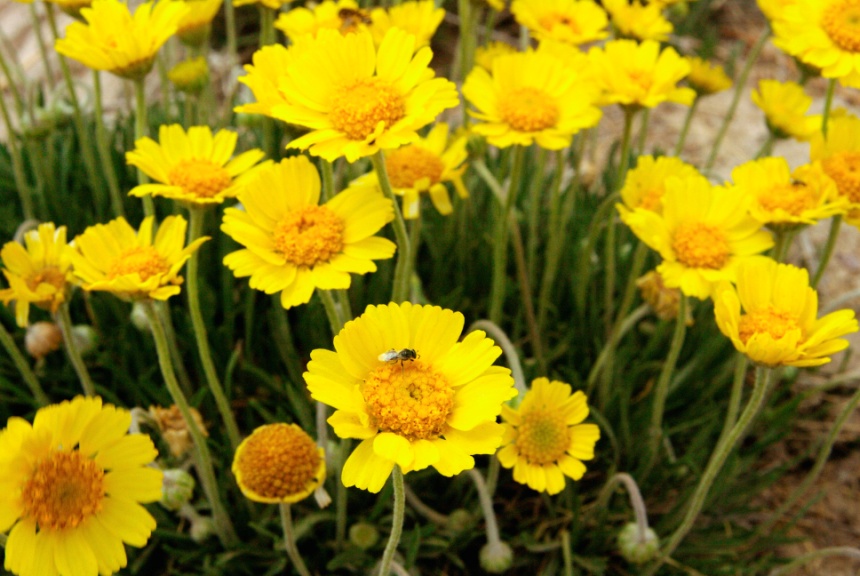Angelita Daisy in the Landscape

Stephen Love, University of Idaho
Scientfic Name: Hymenoxys acaulis (Tetraneuris acaulis)Common Name: Angelita daisy, stemless four-nerve daisy, sundancer daisy
Description: Angelita daisy is a fairly small, herbaceous perennial that produces sunny bright daisies all summer long. The fuzzy, linear to spoon-shaped leaves, form a strong, healthy basal mat. Leaves vary in color from medium green to silver-green, depending on plant source. Wiry stems, produced in successive waves, are each topped by a single 2” flower. Many forms of this species exist in nature. Flowerings stems of some just barely rise above the foliage while others produce slender, graceful stems up to 18 inches tall. Bloom period lasts from late May into October. Angelita daisy is an outstanding addition to any dry rock garden, water-conserving landscape, or low-maintenance short-grass meadow.
Native Habitat: Hymenoxys acaulis can be found growing wild throughout much of the interior western US where it inhabits dry grasslands, shrub-steppe communities, rocky flats and slopes, and pinyon forests. This widespread species grows at elevations ranging from 4,500 to 12,000 feet.
Cultural Requirement
Soil: Adaptable to almost any soil type. Requires good drainage if grown with supplemental moisture. Plant longevity and appearance are best in soils with low to moderate fertility. Prefers soils with moderate to high pH.
Moisture Tolerance: Prefers moderately dry situations, but will grow under a range of soil moisture conditions from dry to moderately moist (with good soil drainage). Blooms longer and more abundantly when provided with supplemental water.
Sun/Shade/Preference: Requires full sun for optimal flowering.
Transplanting: Successful transplanting of small seedlings requires careful root preservation followed by exposure to optimal growing conditions. Potted plants with an established root-ball transplant easily into the garden. Potted plants grow at a moderate pace after transplanting and consistently bloom profusely the first season in the garden.
Propagation: Grows easily from seed. Seeds require no stratification or other treatment and consistently germinate at high rates. Young seedlings grow very slowly and require good pot drainage and high light conditions to survive the first few weeks. Do not overwater in the seedling stage. Seedlings should have at least 4 to 5 leaves before being teased out of flats. Small plants may not survive the bare-root process. Starting seedlings in plug trays may be the best practice. Plants will bloom in pots if given enough time. Maintaining plants long-term in pots up to 1-gallon size is feasible but requires careful water management (kept on the dry side).
Maintenance (pruning, fertilization, deadheading, division, irrigation, etc): Angelita daisy is a carefree plant. Deadhead old blooms to enhance appearance and encourage new flowers. Requires some supplemental irrigation for maximum bloom, once every 3 weeks during the hottest summer months. Fertilizer is required only if plants show poor vigor.
Insect, disease, or other problems: Angelita daisy has no common disease or pest problems.
Landscape Value
Use in the Landscape: Angelita daisy can add season-long color to many sites in the landscape. Small stature makes it most effective in rock gardens, low beds, and small borders. It works best when grouped or massed to enhance the color impact. The long bloom and attractiveness to insects make it a valuable addition to any pollinator garden.
Weediness/Invasive Potential: Angelita daisy will produce a few volunteer seedlings around the parent plants. These are easily controlled or used as replacement plants and behavior is not considered aggressive or invasive.
Foliage: Foliage of Angelita daisy varies by plant source and form. All forms produce a basal mat of small leaves, which ranges in appearance from a loose mound to an extremely dense cushion. Leaf shape ranges from linear to narrowly spoon-shaped.
Flower: The daisy-like flowers are bright yellow and about 2 inches in diameter.
Timing: May-October.
Fruit: One flower head produces numerous fruits which consist of single, tufted achenes (seeds).
Form: Plant source dictates form. Dwarf forms produce symmetrical mounds. Taller forms, in flower, provide a loose, graceful appearance.
Texture: Moderately coarse.
Ultimate Size: Prior to bloom, the plants are 3 to 6 inches tall and slightly wider. Dwarf forms remain the same height in bloom while taller forms grow up to 18 inches tall.
Rate of Growth: Angelita daisy is slow growing in the seedling stage after which it grows at a moderate rate. Plants bloom profusely the first season in the garden.
Suggested Plant Partners: Group Angelita daisy in beds and mixed borders around small drought-tolerant shrubs such as Salvia dorrii, Amorpha nana, and Dasiphora fruticosa. Mix with other diminutive perennials and grasses such as Agastache cusickii, Penstemon eriantherus, Eriogonum thymoides, Eriogonum ovalifolium, Festuca idahoensis, and Bouteloua gracilis.
Availability: Occasionally available as potted plants from mail-order native plant nurseries. Seed can be purchased from native plant seed suppliers.
Cultivars: There are no named cultivars of Angelita daisy in the nursery trade. However, nurserymen have taken advantage of the many botanical species and varied forms of this species to create an interesting array of offerings. Shop around to find a plant form that suits your needs.
References:
Mee, W., Barnes, J., Kjelgren, R., Sutton, R., Cerny, T. and Johnson, C. 2003. Water Wise: Native Plants for Intermountain Landscapes. Utah State University Press, Logan, UT.
Nicholls, G. 2002. Alpine Plants of North America: An Encyclopedia of Mountain Flowers from the Rockies to Alaska. Timber Press, Portland, Oregon.
Nold, R. 2008. High and Dry: Gardening with Cold Hardy Dryland Plants. Timber Press, Portland, Oregon.

